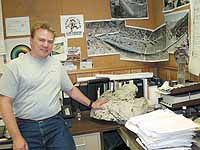| Ken Fleck pauses for a moment beside his dinosaur footprint. His fascination with the footprints and signs of a bygone era are well known around the mine and Fleck enjoys good natured teasing about his excitement at each new find. |
Deer Creek Geologist Ken Fleck spends roughly two days a week underground with a measuring tape, pencil and paper mapping the geologic conditions of PacifiCorp’s mine in Huntington Canyon. He documents the coal thickness and type of rock on the roof and floor of the mine so he can predict coal quality. Among other things, Deer Creek coal contains traces of fossilized tree sap, better known as amber.
You might recall amber from the opening scene of the movie “Jurassic Park” where DNA from a mosquito trapped in this semi-precious gem is extracted to clone dinosaurs. Fleck has yet to find an insect in the mine’s tiny fragments of amber, but he can’t stop checking.
His curiosity could have something to do with the dinosaurs – dinosaur footprints, to be precise, roughly one to two feet in diameter discovered throughout the mine. “Most are rounded, have three toes and look like they were made by a cartoon character,” Fleck reports. In actuality, duck-billed dinosaurs made them; swamp dwellers that fed on the swamp bottom muck some 80 million years ago. “The mud impressions filled with sand and over millions of years hardened into sandstone.”
In various parts of the mine, Fleck can show you a dozen footprints in the sandstone overlying the coal. He’ll also take you to see petrified stumps from the underside of the roof – known as “kettle bottoms” – as well as fossils of palms, ferns and leaves of sequoia and oak-like trees.
Southern Utah is a hotbed for prehistoric footprints and plant material, which, unlike rare skeletal fossils, are not considered significant paleontologic finds and so become finder’s keepers. The mine has donated dinosaur footprints to the local prehistoric museum. Deer Creek miners have collected a few of their own, but for most of the mine’s employees, these types of common fossils are like ceiling wallpaper on the mine roof.
Fleck’s interest, though, extends beyond geologic curiosity. Safety, as always, is thought of first.
“The way plant material is laid down can affect the strength of the roof rock,” he explains. “We have to be extra cautious when working in roof areas with abundant plant material.”
Deer Creek Mine produces four million ton of coal per year for use at the Huntington Canyon and Hunter Plants. Approximately 300 miners work at the mine producing coal. The underground mine is actually in the side of a layered mountain topped by U.S. Forest Service land, 1,600 feet above. The forest service is the landlord, and Deer Creek is the lessee: the subsidence, or settling of the forest land due to the Deer Creek mining operations, is carefully monitored. Since mining operations began in the early 70s, Deer Creek’s footprint on the land is negligible. Which is more than we can say for the giant footprints left by the beings who ‘leased’ this land during the Cretaceous period 80 million years ago.

